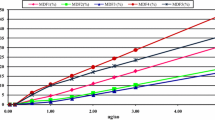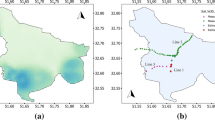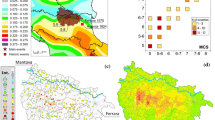Abstract
We performed large-scale earthquake economic loss estimations for France and cost–benefit analyses for several French cities by developing a semiempirical, intensity-based approach. The proposed methodology is inexpensive and easily applicable in case of a paucity of detailed information regarding the specific regional seismic hazard and the structural characteristics of the building stock, which is of particular importance in moderate-to-low seismic hazard regions. The exposure model is derived from census datasets, and the seismic vulnerability distribution of buildings is calculated using data mining techniques. Several hypothetical, large-scale retrofit scenarios are proposed, with increasing levels of investment. These cities, in their respective reinforced states, are then subjected to a series of hazard scenarios. Seismic hazard data for different return periods are calculated from regulatory accelerations from French seismic zoning. Loss estimations for the original (non-reinforced) configuration show high levels of expected building repair and replacement costs for all time spans. Finally, the benefits in terms of damage avoidance are compared with the costs of each retrofit measure. Relatively limited strengthening investments reduce the probability of building collapse, which is the main cause of human casualties. However, the results of this study suggest that retrofitting is, on average, only cost-effective in the parts of France with the highest seismicity and over the longest time horizons.









Similar content being viewed by others
References
AFPS (1996) Le séisme d’Epagny (Haute-Savoie) du 15 juillet 1996. In: AFPS (ed) Rapport de mission, Paris, pp 128–22
Atkinson G, Kaka S (2007) Relationships between felt intensity and instrumental ground motion in the central United States and California. Bull Seismol Soc Am 97(2):497–510. doi:10.1785/0120060154
Benson C, Twigg J (2004) Measuring mitigation: methodologies for assessing natural hazard risks and the net benefits of mitigation—a scoping study. International Federation of Red Cross and Red Crescent Societies/the ProVention Consortium, p 153
Bommer J, Crowley H (2006) The influence of ground-motion variability in earthquake loss modelling. Bull Earthq Eng 4:231–248. doi:10.1007/s10518-006-9008-z
Boser BE, Guyon IM, Vapnik VN (1992) A training algorithm for optimal margin classifiers. In: Haussler D (ed) 5th annual ACM workshop on COLT, ACM Press, Pittsburgh, PA, pp 144–152
Brookshire D, Chang S, Cochrane H, Olson R, Rose A, Steenson J (1997) Direct and indirect economic losses from earthquake damage. Earthq Spectra 13(4):683–701
Corbane C, Hancilar U, Ehrlich D, De Groevel T (2016) Pan-European seismic risk assessment: a proof of concept using the earthquake loss estimation routine (ELER). Bull Earthq Eng. doi:10.1007/s10518-016-9993-5
Cortes C, Vapnik V (1995) Support-vector networks. Mach Learn 20:273–297
Di Pasquale G, Goretti A (2001) Vulnerabilità funzionale ed economica degli edifici residenziali colpiti dai recenti eventi sismici italiani—X Congresso Nazionale “L’ingegneria Sismica in Italia”
Douglas J, Ulrich T, Negulescu C (2013) Risk-targeted seismic design maps for mainland France. Nat Hazards 65(3):1999–2013. doi:10.1007/s11069-012-0460-6
Dunand F, Guéguen P (2012) Comparison between seismic and domestic risk in moderate seismic hazard prone region: the Grenoble City (France) test site. Nat Hazards Earth Syst Sci 12:511–526. doi:10.5194/nhess-12-511-2012
EC8 (2005) Eurocode 8—design of structures for earthquake resistance—part 1: general rules, seismic actions and rules for buildings. European Standard EN 1998–1, Comité Européen de Normalisation, Brussels, Belgium
Faenza L, Michelini A (2010) Regression analysis of MCS intensity and ground motion parameters in Italy and its application in ShakeMap. Geophys J Int 180(3):1138–1152. doi:10.1111/j.1365-246X.2009.04467.x
FEMA (1994a) Typical costs for seismic rehabilitation of existing buildings (FEMA 156). 2nd edn. Earthquake hazards reduction series 39
FEMA (1994b) Typical costs for seismic rehabilitation of existing building. 2nd edn. Vol 2-supporting documentation. (FEMA 157)
FEMA (2003) HAZUS-MH technical manual, federal emergency management agency (FEMA 443). National Institute of Building Sciences, Washington
GEOTER-HAUSS (2011) Réalisation d’une etude de presumption de vulnérabilité sismique et de pertinence de renforcement sur les bâtiments de classe C et D et l’ensemble des établissements scolaires de la commune de Lourdes (65). Rapport GTR/DDT65/0511-855
Grünthal G, Levret A (2001) L’échelle macrosismique européenne. Conseil de l’Europe—Cahiers du Centre Européen de Géodynamique et de Séismologie. p 19
Guettiche A, Guéguen P, Mimoune M (2017) Seismic vulnerability assessment using association rule learning—application to the city of Constantine, Algeria. Nat Hazards 86(3):1223–1245. doi:10.1007/s11069-016-2739-5
Jackson J (2006) Fatal attraction: living with earthquakes. The growth of villages into megacities and earthquake vulnerability in the modern world. Philos Trans R Soc 364(1845):1911–1925
Kappos AJ, Panagopoulos G, Panagiotopoulos C, Penelis G (2006) A hybrid method for the vulnerability assessment of R/C and URM buildings. Bull Earthq Eng 4(4):391–413
Lagomarsino S, Giovinazzi S (2006) Macroseismic and mechanical models for the vulnerability and damage assessment of current buildings. Bull Earthq Eng 4:415–443. doi:10.1007/s10518-006-9024-z
Marin S, Avouac JP, Nicolas M, Schlupp A (2004) A probabilistic approach to seismic hazard in metropolitan France. Bull Seismol Soc Am 94(6):2137–2163
Martin C, Combes P, Lignon G, Fioravanti A, Carbon D, Monge O, Grellet B (2002) Révision du zonage sismique de la France: Etude probabiliste. Technical report. Rapport de Phase 3, GEO-TER, France, report GTR/MATE/0701-150, Affaire no. 1601, in French
Martin C, Secanell R, Viallet E, Humbert N (2008) Consistency of PSHA models in acceleration and intensity by confrontation of predictive models to available observations in France. In: CSNI workshop on “recent findings and developments in PSHA methodologies and applications”, Lyon-France, 7–9 April 2008
MEDD (1982) Le risque sismique, Délégation aux risques majeurs (in French)
Riedel I (2015) Analyse de la vulnérabilité du bâti existant. Estimation et réduction des incertitudes dans l’estimation des dommages et des pertes pour un scénario sismique donné. Ph.D. Grenoble (France), Université Grenoble Alpes. https://tel.archives-ouvertes.fr/browse/last
Riedel I, Guéguen P, Dunand F, Cottaz S (2014) Macro-scale vulnerability assessment of cities using association rule learning. Seismol Res Lett 85(2):295–305. doi:10.1785/0220130148
Riedel I, Guéguen P, Dalla Mura M, Pathier E, Leduc T, Chanussot J (2015) Seismic vulnerability assessment of urban environments in moderate-to-low seismic hazard regions using association rule learning and support vector machine methods. Nat Hazards 76(2):1111–1141. doi:10.1007/s11069-014-1538-0
SIA (2004) Vérification de la sécurité parasismique des bâtiments existants (SIA 2018). Societé Suisse des ingénieurs et des architectes, Zurich
Smyth A, Altau G, Deodatis G, Erdik M, Franco G, Gülkan P, Kunreuther H, Lus H, Mete E, Seeber N, Yüzügüllü Ö (2004) Probabilistic benefit-cost analysis for earthquake damage mitigation: evaluating measures for apartment houses in Turkey. Earthq Spectra 20(1):171–203
So E, Spence R (2012) Estimating shaking-induced casualties and building damage for global earthquake events: a proposed modelling approach. Bull Earthq Eng 11:347–363. doi:10.1007/s10518-012-9373-8
Spence R, Lebrun B (2006) Earthquake scenarios for European cities: the risk-UE project. Bull Earthq Eng 4 (special issue)
Spence R, Bommer J, del Re D, Bird J, Aydinoglu N, Tabuchi S (2003) Comparing loss estimation with observed damage: a case study of the 1999 Kocaeli earthquake in Turkey. Bull Earthq Eng 1:83–113
Tyagunov S, Pittore M, Wieland M, Parolai S, Bindi D, Fleming K, Zschau J (2014) Uncertainty and sensitivity analyses in seismic risk assessments on the example of Cologne, Germany. Nat Hazards Earth Syst Sci 14:1625–1640. doi:10.5194/nhess-14-1625-2014
USGS (2015) U.S. geological service website. Available from: http://earthquake.usgs.gov/earthquakes/eqarchives/. Last Accessed Apr 2015
Valcarcel J, Mora M, Cardona O, Pujades L, Barbat A, Bernal G (2013) Methodology and applications for the benefit cost analysis of the seismic risk reduction in building portfolios at broadscale. Nat Hazards 69:845–868. doi:10.1007/s11069-013-0739-2
Whitehead J, Rose A (2009) Estimating environmental benefits of natural hazard mitigation with data transfer: results from a benefit-cost analysis of Federal Emergency Management Agency hazard mitigation grants. Mitig Adapt Strateg Glob Change 14:655–676. doi:10.1007/s11027-009-9189-2
Acknowledgements
This work was supported by the MAIF Foundation. INSEE data were prepared and provided by the Centre Maurice Halbwachs (CMH). This study was sponsored by the Urban Seismology project at the Institute of Earth Science ISTerre of the University of Grenoble-Alpes and by a grant from Labex OSUG@2020 (Investissements d’avenir, ANR10-LABX56).
Author information
Authors and Affiliations
Corresponding author
Rights and permissions
About this article
Cite this article
Riedel, I., Guéguen, P. Modeling of damage-related earthquake losses in a moderate seismic-prone country and cost–benefit evaluation of retrofit investments: application to France. Nat Hazards 90, 639–662 (2018). https://doi.org/10.1007/s11069-017-3061-6
Received:
Accepted:
Published:
Issue Date:
DOI: https://doi.org/10.1007/s11069-017-3061-6




